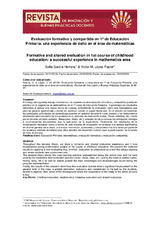| dc.contributor.author | García Herranz, Sofía | |
| dc.contributor.author | López Pastor, Víctor M. | |
| dc.date.accessioned | 2019-09-04T10:32:13Z | |
| dc.date.available | 2019-09-04T10:32:13Z | |
| dc.date.issued | 2019 | |
| dc.identifier.issn | 2531-1336 | |
| dc.identifier.uri | http://hdl.handle.net/10396/18963 | |
| dc.description.abstract | A lo largo del siguiente trabajo mostramos una experiencia de evaluación formativa y compartida puesta en práctica en la asignatura de matemáticas en el 1º curso de Educación Primaria. Exponemos los resultados obtenidos al aplicar una nueva forma de evaluar, entendiendo la evaluación como una herramienta que permite generar aprendizaje y donde los alumnos cobran un papel destacado. En el estudio se muestran las principales actividades de aprendizaje puestas en práctica durante el curso escolar y los instrumentos empleados tanto por parte de los alumnos en su proceso de evaluación (caras, Óscar, estrellas, etc.) como por el docente (escalas verbales, filmaciones, diario, etc.); además de dar a conocer las principales ventajas e inconvenientes encontradas tras la aplicación de la experiencia. Finalmente, los resultados de la investigación muestran como a través de este sistema de evaluación se produce una mejora significativa en el nivel general de la clase, una mayor motivación, autonomía y compromiso hacia la tarea por parte de los alumnos, además de fortalecerse otros ámbitos del desarrollo; siendo clave la participación de la familia en todo el proceso. | es_ES |
| dc.description.abstract | Throughout this doctoral thesis, we show a formative and shared evaluation experience and it was implemented during mathematics subject of 1st course of childhood education. We present the obtained results by applying a new evaluating way, in which, evaluation is understood as a tool that allows learning and where students take a prominent role. The doctoral thesis shows the main learning activities implemented during the school year and the tools used by the students in their evaluation process (faces, Oscar, stars, etc.) and by the teacher (verbal scales, filming, diary, etc.); as well as makes publish the main advantages and disadvantages found during the program implementation.Finally, the results of the research show how this evaluation system allow a significant improvement in the general level of the class, a greater motivation, autonomy and commitment to the task by the students, beside to improve other areas of the development where the cooperation of the family in the whole process is key. | es_ES |
| dc.format.mimetype | application/pdf | es_ES |
| dc.language.iso | spa | es_ES |
| dc.publisher | UCOPress | es_ES |
| dc.rights | https://creativecommons.org/licenses/by-nc-nd/4.0/ | es_ES |
| dc.source | Revista de innovación y buenas prácticas docentes 8 (1), 48-57 (2019) | es_ES |
| dc.subject | Educación Primaria | es_ES |
| dc.subject | Matemáticas | es_ES |
| dc.subject | Evaluación formativa | es_ES |
| dc.subject | Evaluación compartida | es_ES |
| dc.subject | Childhood education | es_ES |
| dc.subject | Mathematics | es_ES |
| dc.subject | Formative evaluation | es_ES |
| dc.subject | Shared evaluation | es_ES |
| dc.title | Evaluación formativa y compartida en 1º de Educación Primaria: una experiencia de éxito en el área de matemáticas | es_ES |
| dc.title.alternative | Formative and shared evaluation in 1st course of childhood education: a successful experience in mathematics area | es_ES |
| dc.type | info:eu-repo/semantics/article | es_ES |
| dc.relation.publisherversion | http://www.uco.es/ucopress/ojs/index.php/ripadoc/index | es_ES |
| dc.rights.accessRights | info:eu-repo/semantics/openAccess | es_ES |

